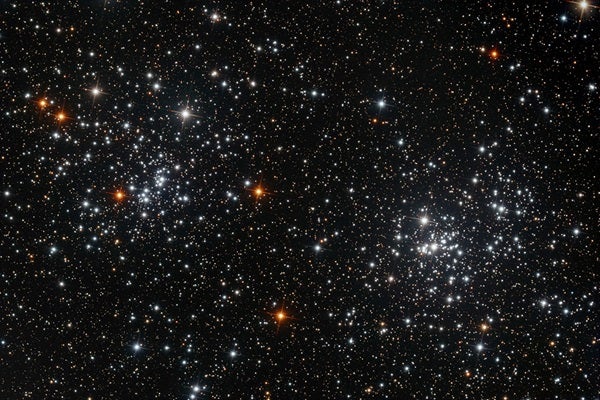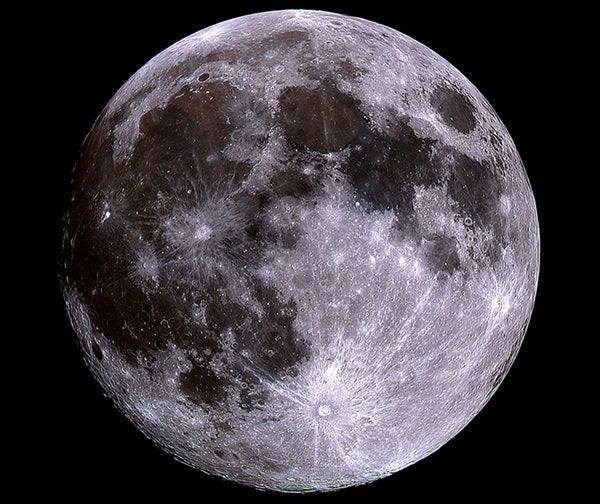One of the sky’s most familiar constellations rules January’s sky from dusk until 2 a.m. local time. Orion the Hunter appears conspicuous in the southeast after darkness falls and climbs highest in the south around 9 p.m. It then stands halfway to the zenith from mid-northern latitudes. If you’ve watched Orion over the years, you might notice that it doesn’t look quite the same now. Ruddy Betelgeuse, which marks one of the Hunter’s shoulders, is a mere shadow of its former self, glowing near magnitude 1.5. This is about a magnitude fainter than usual and noticeably dimmer that Aldebaran in neighboring Taurus, a star that Betelgeuse normally beats handily. Astronomers are trying to figure out why this known variable star has dimmed to its faintest level in more than a century.
Saturday, February 1
First Quarter Moon arrives at 8:42 p.m. EST. You can find the half-lit orb high in the south as darkness falls and then watch it sink toward the western horizon throughout the evening hours. The Moon spends the night hugging the border between the constellations Aries the Ram and Cetus the Whale.
Comet PanSTARRS (C/2017 T2) glows at 9th magnitude this week as it makes its way northward along the Milky Way near the Perseus-Cassiopeia border. Tonight, this visitor from the distant Oort Cloud lies 1° northwest of the Double Cluster (NGC 869 and NGC 884) and 1° south of the pretty binocular cluster Stock 2. Although this region of sky remains visible all night, it lies highest in the north during the early evening hours.
For those who believe in folklore, the fate of winter rests on the shoulders of the groundhog. If the furry rodent sticks his head out of his burrow this morning and sees his shadow, we’ll have six more weeks of winter. But if the weather is cloudy, it means spring is right around the corner. What does this have to do with astronomy? Groundhog Day celebrates one of the four so-called cross-quarter days, which mark the midpoints between the solstices and equinoxes. February 2 falls approximately midway between the winter solstice and the vernal equinox.
Monday, February 3
The waxing gibbous Moon lies just north of the Hyades star cluster in Taurus the Bull this evening. The Hyades’ brightest stars form a V-shaped asterism highlighted by 1st-magnitude Aldebaran, a foreground star that forms one tip of the V. As the night rolls on and the heavens wheel overhead, the Moon shifts eastward. And for those who live south of a line that runs from northern Virginia to central Nebraska, Luna passes in front of magnitude 3.5 Epsilon (ε) Tauri, the star marking the northeastern tip of the cluster. Binoculars will provide the best view of this impressive conjunction.
Tuesday, February 4
Mercury has embarked on what promises to be its best evening apparition of 2020. Tonight, it appears 9° high in the west-southwest 30 minutes after sunset. The inner world shines at magnitude –0.9, bright enough to show up against the twilight glow. (If you don’t see it right away, binoculars will bring it into view.) A telescope reveals Mercury’s disk, which spans 6.1″ and appears three-quarters lit. The innermost planet will reach its peak at greatest elongation next week.
Wednesday, February 5
The variable star Algol in Perseus appears faintest at 12:21 a.m. EST tomorrow morning, when it shines at magnitude 3.4. If you start watching it immediately after darkness falls tonight, you can see it dim from its peak brightness (magnitude 2.1) to minimum and then start brightening again. This eclipsing binary star runs through a cycle from minimum to maximum and back every 2.87 days, but the drop from peak brightness and subsequent rise lasts only about 10 hours. Algol appears nearly overhead at the end of evening twilight and descends toward the northwestern horizon well after midnight.
Thursday, February 6
Venus gleams in the southwestern sky after sunset. The brilliant planet stands out just a half-hour after sundown, when it appears 30° above the horizon, and it is still 20° high once darkness settles in. Venus remains on display until nearly 9 p.m. local time. Shining at magnitude –4.1, it is by far the brightest point of light in the night sky. A telescope shows the planet’s disk, which spans 16″ and appears 71 percent lit.
Friday, February 7
Ruddy Mars grows more prominent before dawn with each passing week. The Red Planet now rises before 4 a.m. local time and climbs 20° above the southeastern horizon an hour before sunrise. Mars glows at magnitude 1.3 against the backdrop of Ophiuchus the Serpent-bearer. Unfortunately, a telescope doesn’t add much to our view of the planet, revealing a bland disk that measures only 5″ across.
Full Moon occurs at 2:33 a.m. EST tomorrow morning (11:33 p.m. PST this evening), but our satellite looks completely illuminated all night. You can find it rising in the east around sunset and peaking high in the south just after midnight. The Moon spends the night near the border between the constellations Cancer the Crab and Leo the Lion.
Sunday, February 9
The nearly fully lit Moon appears in the company of 1st-magnitude Regulus tonight. The pair rises in the east before 7 p.m. local time and climbs high in the south around 1 a.m. Only 4° — about eight times the Moon’s apparent diameter — separate the two.
Although Jupiter passed on the far side of the Sun from Earth just six weeks ago, it has returned to view before dawn. The giant planet rises nearly two hours before the Sun and climbs 8° above the southeastern horizon an hour before sunup. Shining at magnitude –1.9, Jupiter stands out nicely against the twilight glow.












